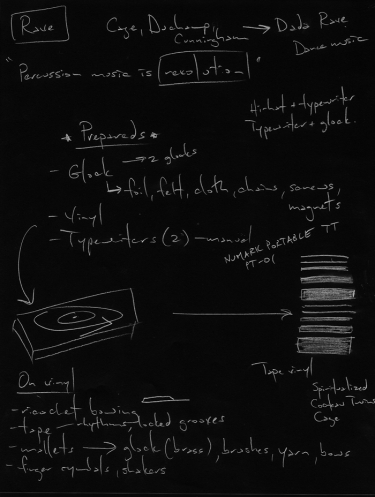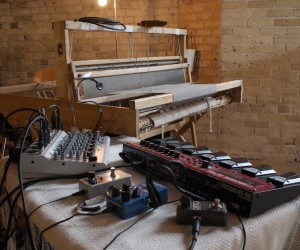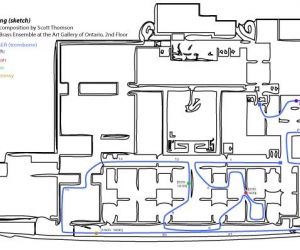
I asked Nicole Lizée, newly commissioned to compose a work to commemorate the hundredth anniversary of John Cage’s birth, if she has ever before composed with that iconic artist in mind. How could she not? She is, after all, known for her nonstandard use of instruments, prepared turntable, found objects, and dance music—all elements associated in varying degrees with Cage. But Lizée informs me that although she has always been inspired by Cage’s drive to stay true to himself and to pursue innovative sound ideas, she has not until now composed with him explicitly in mind.
The new piece by Lizée, to be premiered in March 2012, was jointly commissioned by New York percussion quartet So Percussion and Soundstreams, and is her expression of Cage’s spirit, with Lizée inviting listeners to the kind of rave that she imagines he would create.
GLORIA LIPSKI: Tell me about your latest piece.
NICOLE LIZÉE: It’s a homage to Cage’s specific philosophies and his words, which have had such an impact on me. I started with his statement that “percussion music is revolution.” He was the first composer to use the turntable—he used it in Imaginary Landscapes. I have a love for the turntable and I’ve experimented a lot with it from a scratch DJ approach. In this piece, I’m using the turntable as a percussion instrument—sort of an objet trouvé approach. I’ll be playing the turntables with So Percussion, and I want them to treat my turntable playing like it’s part of a multi-percussion setup.
How did you choose the rest of the instrumentation for this piece?
Some of it was a logistical concern. So Percussion wanted the show to be continuous, without intermission, so I wanted to keep my setup fairly small. I’m also using the word revolution both in the sense of a turntable revolving and in the sense of stereophonic sound in the round. It’s a stereophonic piece with two sets of identical setups: two people with typewriters, two people with turntables, two kick drums, two glockenspiels.
Typewriters?
Music can come out of anything; rhythm can come out of anything. So the typewriter will be another percussion instrument. I’m also using it to represent [Cage’s] writings.
Are there pitched components? Will the records themselves have pitched samples?
Yeah, I’ll probably use records that were used initially to test stereo systems in the ’60s. There’s sine waves and [different] frequencies. I use those a lot because I can manipulate the pitch and create melodies that I want to merge with the glock—a melody on the glock with this added layer underneath, like these sine waves. I’m tuned into the sounds, and the thrill lies in taking those sounds and putting them in different situations, different environments, and seeing what can be done. Not just having the turntable there—that’s not enough—but having it as a percussion instrument. It’s not just the focal point, it’s part: it’s like a cymbal; it’s like another cymbal or another glock or like a vibraphone. I’m into the possibilities that emerge when you take something and don’t just focus on it— when you put it in a context with everything else.
Are you using any other references to Cage in the piece?
[Cage] completely revolutionized certain approaches—for example, his prepared piano pieces, which are phenomenal. He had this amazing ability to take something and draw out of it things that you had no idea were there. I’m trying to take the idea of preparing and applying it to everything from the glockenspiel—using chains on it, using different ways to mute it, using felt and cloth and everything—to the records themselves. I’m preparing the records so that they play certain rhythms: for example, if I take the vinyl and put tape on it or scratch it up . . . the stylus will skip over top of this and create a rhythm. In recent years I’ve enjoyed pushing the limits of minute, precise rhythms, rhythms that mutate over time, and then turn into something else; playing with feel and tempo and shifts and accents, superimposing rhythms. So this piece is definitely a progression from that. They’ll be playing this prepared record and the piece will grow out of that.
You mentioned that the new piece is structured as a dance piece.
I’m fascinated by rave culture and I’m fascinated by Cage’s affiliation with dance. I would have loved it if he had hosted a rave somewhere, in 1990, 1992, when it was at its peak. That would have been fantastic. I would go to that rave. So all in all, at the end of it, it is a dance piece. It’s Cage’s rave and everything that would be involved in his rave—and there would be typewriters there.
Image: Courtesy of the artist


